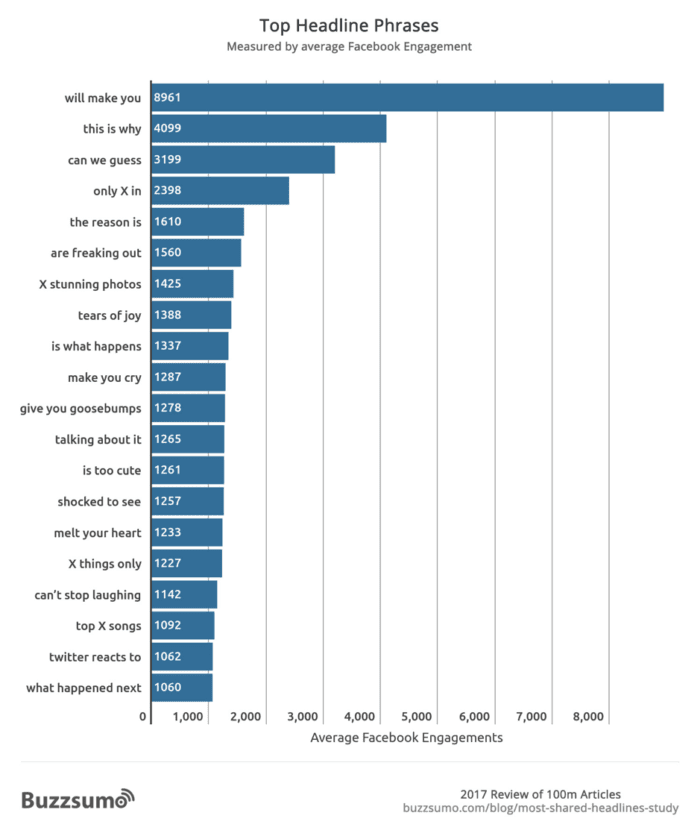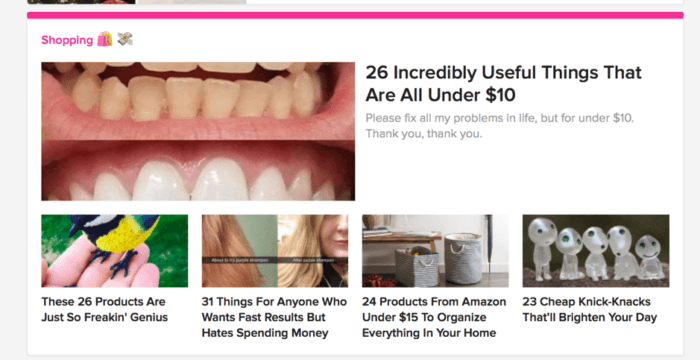A headline can make or break your content
A good headline drives traffic, social media shares, and even helps (indirectly) generate leads. A bad headline, on the other hand, will get overlooked. There is too much amazing content being published every day and if you want to be able to compete with it, you not only need quality content that provides value, but also a headline that will make people want to click on your links, as well as share your articles with their own friends and followers.
In this blog post, I’m going to show you how to write headlines that drive traffic.
Step 1: Use relevant keywords in your headlines
Keywords not only help with your search engine optimization (as those are the words people use to search for content like yours), but they also make it clear what your article is about.
Even before you start writing a blog post or any other type of content, you should first spend some time researching keywords and writing down those that would make great focus keywords.
Use a keyword tool like Ubersuggest or the Moz Keyword Explorer to start looking up relevant keywords:

These tools will also provide keyword suggestions of similar long-tail keywords (of 2 or more words) that people search for, along with their monthly search volume (how many people search for them).
Write down any relevant keywords you find into a spreadsheet, along with their monthly search volume; then, you can decide which of these keywords you want to focus on and use as a basis for your content and to write more effective headlines.
Step 2: Use words that make people want to read your content
Last year, Buzzsumo (a content research and influencer marketing tool) wanted to see what makes people want to click on a headline; they researched 100 million headlines between March and May of 2017 and made some interesting findings – by far the most used phrase in the most popular headlines is “will make you”:

Other popular word were “this is why”, “can we guess”, “only X in”, and “the reason is”. Following that, most of the headlines that follow contain words that are designed to provoke emotion: freaking out, tears of joy, make your cry, melt your heart, and so on.
So, what can we learn from this?
For one, that you really need to try using “will make you” and “this is why” in some of your headlines.
And two, if possible, use words that tug at people’s hearts or their emotions – these types of words and headlines work particularly well on social media (therefore, more shares).
Step 3: Listicles, listicles, listicles!
We love listicles. Probably because they’re easy and quick to read, especially if you’re on a smartphone. They’re also very easy to skim. And, in some cases, they can really arouse our curiosity.
They’re so popular in fact, that some of the world’s most successful online publications pretty much only rely on listicles – yes, I am talking about Buzzfeed.

And there’s lots of data to back this claim up; like this study made by CoSchedule and OKDork that found that listicle posts are the clear winners of online content:

Listicles with 10 in the title tend to get more social media shares.
So when you write a blog post try to think if there is any way to structure it into a listicle – and write a headline to match.
A few examples:
- 10 tips that will turn your blog into a lead generation machine
- 5 steps to building the perfect website
- How to grow your business with these 10 amazing tools
Step 4: How do you do that?
“How to” is one of the most popular ways of starting a google search. From everyday problems like “how to make a cake” (well, maybe not every day) to more complex questions like “how to generate electricity from waste” and “how to market your business on a budget”, these types of Google searches are extremely common and therefore, people want to read these types of posts.
Plus, these types of headlines are usually very clear and to the point and the reader expects to get exactly what they were promised in the headline.
“How to” headlines also provide value to the reader: you’re teaching them how to do something that they want to learn (especially if you do your – keyword – research and learn what your audience’s questions and needs are).
And the great news is that, like listicles, it doesn’t matter what niche you’re in – there is always something that you can show your audience how to do.
A few examples:
- How to write headlines that drive traffic
- How to build the perfect website
- How to generate leads on autopilot
Step 5: Analyse your headlines and learn
As you publish more content (and implicitly, headlines), you can start gaining a better understanding of what types of headlines work best for your particular audience, both in terms of the traffic they generate and the social media shares (although the 2 are usually closely related).
To start with, you can check in WordPress which of your blog posts got the most shares – simply click on “social shares” to order them by maximum number of shares:

Ironically, it looks like my most shared blog post is on this exact same subject. This will not only tell you what types of headlines work but also what topics interest your audience.
Next, head over to your Google Analytics account; there, you’ll be able to see which of your blog posts get the most traffic, as well as most social media traffic (which is very important as social media can drive you a lot of traffic so you need to learn what types of headlines and topics make people take action on social media).
To see which pages get the most traffic, go to Behaviour -> Site Content -> All Pages:

To check your social media traffic, go to Acquisition -> Social -> Landing Pages:

Use your analytics to learn from your audience; see what types of headlines get the best results and try to write more content and more headlines in the same vein (same topics, similar keywords, and same headline formats/words).
Conclusion
Headlines are as much of an art as they are a science; while sure, you can definitely follow certain formulas (how to, listicles, using certain words) and get results, you should also experiment with different types of headlines, especially depending on the platform (social media, email, blog, etc.).
However, it’s quite clear that listicles and how to posts are some of the most consistently popular headlines/content types, so try to incorporate more of these types of headlines into your content marketing strategy.
What is your most successful headline ever?